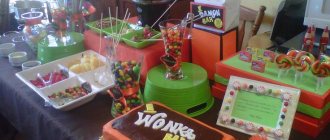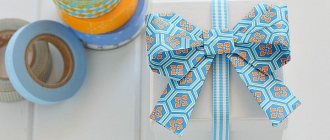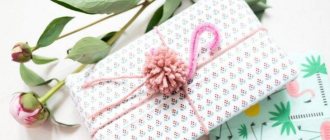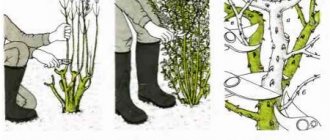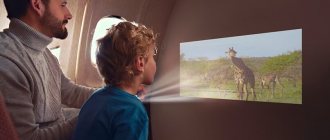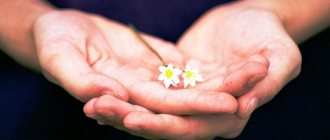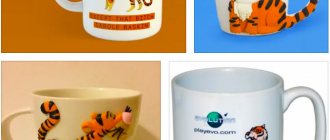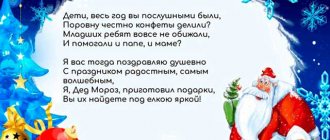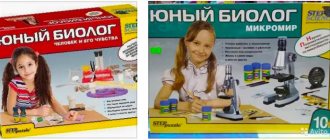Tools and materials
To create a shockbox, of course, you need sweets. The shape and size of the chocolate box depends on the candies.
To create a layout, you will need a computer with Photoshop installed. Or you can use ready-made layouts from the Internet. Since this design will need to be printed, you will need a printer and 90gsm paper for the wrappers and 200gsm paper for the boxes.
You will need scissors to cut out the printouts. And if you also have a cutter, this will make the task easier. But scissors will still be necessary, since it is impossible to make small cuts with a cutter. You will also need a breadboard knife. It can be replaced with a stationery one.
To carefully bend the cut out boxes, you can use a creasing board. It will allow you to draw straight lines. Or you can draw them from the wrong side along the ruler using a stack, dots, or a pen that does not write.
You also need glue, which when applied does not deform the paper. You can use PVA D2 or D3, but not stationery. You will also need a brush to apply the glue.
Creating a layout
At the first stage, you need to decide on sweets.
Usually, Bird's Milk candies are used for shockboxes. These candies are rectangular in shape, which makes it easy to create a template for the future chocolate box. These candies also have two wrappers. When you remove the paper wrapper, the candy remains in the foil. Thanks to this, the candy is protected from any impact.
Next, you decide on the size and shape of the shockbox, that is, the number of candies and their location. Most often, shockboxes are made for 4, 6, 8, 9, 12, 16 candies. Here we will create a box of 8 chocolates in Photoshop.
Even if you do not know all the functions and capabilities of Photoshop, you can create a wonderful layout for the shockbox. Here it is enough to know the principles of working with shapes and be able to insert pictures and texts.
But if suddenly you don’t know how to work with the Photoshop program at all, then you can easily learn this thanks to the Photoshop courses for needlewomen and home craftsmen (abbreviated FRDM) from the Academy of Graphics and Design. They explain in an accessible form the basic principles of working in Photoshop.
In the classes you will learn numerous techniques that will help you create wonderful cards, collages, stamps, seals, patterns and much more. The course already has over 5,000 positive reviews and you can access it via this link:
>>> GET ACCESS TO THE PHOTOSHOP COURSE
The box will consist of two parts:
- an inner box with sides where we will put candy;
- external, where the internal box of candies will slide in (similar to a matchbox).
Having placed the candies on the table in two lines of 4 candies, measure the width (A), length (B) and height (C). We add 2 millimeters to these measurements so that the candies easily fit into the finished box. Since our box will have sides, we need to take this into account when creating the template (side width D).
The template for both the inner and outer box for 8 Bird's Milk candies is placed entirely on an A4 sheet.
In Photoshop, using the Rectangle tool, we begin to create a template.
Inner box template
First, draw the base of box 1. Width of rectangle 1 = A+2D+2mm, length – B+2D+2mm.
Next, draw rectangles 2 and 3. The width of rectangles 2 = C + 2mm, length = the length of rectangle 1 (i.e. B + 2D + 2mm). Width of rectangles 3 = width of rectangle 1, length = C+2mm.
Then draw rectangles 4 and 5. Width of rectangle 4 = D, length = length of rectangle 2. Width of rectangle 5 = width of rectangle 3, length = D.
The width of the rectangles is 6 = the width of the rectangles is 2, and the length = B+2mm. The dimensions of rectangles 7 are the same as those of rectangles 3. The side of figures 8, which is adjacent to rectangles 4, is equal to D, and the opposite side of figure 8 should be slightly smaller. This is done to make it easier to assemble the box. The other two sides should be equal to or slightly less than the width of the rectangles 6.
For the remaining figures, one side, which is adjacent to the already drawn figures, corresponds to the size of these figures. The opposite side should be slightly smaller for ease of assembly. And the other two sides can be arbitrary.
On rectangles 5 and 7 we draw stripes for the slot at a distance equal to D from the edge of the rectangles. Figures 8 will be inserted into these slots during assembly.
The inner box template is ready.
Outer box template
To create a template for the outer box, you need to draw two rectangles 1* and 2*. The height of these rectangles is equal to the height of rectangle 1 of the inner box. The width of these rectangles is 1-2mm greater than the width of rectangles 1 and 2 of the inner box, respectively. If you make rectangles 1* and 2* equal to rectangles 1 and 2 respectively, then you will not be able to insert one box into the other.
The remaining figure has one side that is adjacent to rectangle 1*, equal to the height of this rectangle. The opposite side needs to be drawn a little smaller. And the width of this figure should be less than the width of figure 2* by a couple of millimeters. So that when assembled you get a neat box.
Candy wrapper template
To create a wrapper template, you can simply remove the factory wrapper from the candy and measure its dimensions, but you can also create your own. You just need to take into account the size of the candy itself.
When creating a template for the wrapper with your own dimensions, base it on the dimensions of the candy. The width of the template is obtained from the sum of the width and height of the candy, multiplied by two, plus the width of the area for gluing; the height of the template should not exceed the length of the candy.
Design of box and wrapper layout
After creating the templates, you can start designing them.
Here you can give free rein to your imagination and use absolutely any pictures, photographs, texts. To find them, you can use any search engine, or you can use your own photographs and texts.
You can even make a collage, taking a frame from a movie, and instead of the hero, insert a photo of the person for whom you are making this shockbox. This technique was described in detail at FRDM 9.
The main thing when designing layouts is to do everything in the same style and choose high-quality images.
Using the same template and inserting different design elements, background images, photographs, texts, you can create layouts for shockboxes for any holidays or events.
Design is created for the inner and outer boxes, as well as for the wrappers. When creating a layout for wrappers, you need to take into account the number of candies in the shockbox. If you write wishes on wrappers, then you will need to change the inscription for each candy. But you can make one design for all the candies. When preparing wrappers for printing, they all need to be placed on one A4 sheet.
Creating chocolate packaging using photoshop
Well, here is the long-awaited tutorial on working with Photoshop. Please be patient and take time, especially if you are new to this program. To implement our MK, you must have Photoshop installed (the version does not matter, I have Photoshop CS5)
In this Master Class we will make a Box - Packaging for chocolate, or rather its template.
In this Master Class we will make a Box - Packaging for chocolate, or rather its template. We will create a document in Photoshop from the very beginning.
So, first of all, download and save the files for MK
, from a thread on the forum.
1.
Open the Photoshop program. We create a document in A4 format, this is exactly the format we need to fit the template. To do this: click (1) “file” - (2) “create”, in the Set line select (3) - International paper format, Size (4) - A4, (5) - OK.
We have created a document - the “base”
.
You should see a sheet and a window containing layers appear on your screen. The window in which the layers are displayed is called the “layers panel”
; if it is not displayed, you need to activate it by pressing F7.
2.
Now we need to insert an image into our “base” - a
“pattern”
.
To do this: minimize Photoshop and open the folder in which you saved the files for MK, select the “pattern” ! Do not click on the file itself so that it does not open in the photo viewer!
Move the cursor to the desired file icon, hold down the left mouse button and drag this file into Photoshop. If Photoshop appears on your screen and your image is crossed out with two lines diagonally, then you did everything correctly. Press Enter, now the picture has been added to your “base” document, and added as a separate layer (this method of adding an image to an open program file allows you to add an image and it will automatically fit into the format you specify).
We will need the added pattern in order to correctly place pictures and inscriptions on the template, so that in the future everything will be in its place when we make the finished box. The inserted image of the pattern needs to be corrected, and in order for correction of the file inserted in this way to be possible, you need to do the following: Place the cursor on the layers panel and on the line of the layer with the name pattern, right-click, select the line “rasterize layer” and click on it (this is necessary for further editing of the picture).
Next, let's work with the Toolbar
— For me it’s a vertical stripe on the left side of the screen, for you it’s most likely located there. The tools used in our MK are available in any version of Photoshop, but their names may differ.
3.
Now you need to get rid of the white background around and inside the pattern for this:
For clarity, hide the “background”
. Please note that on the line with the name of the layer, at the very beginning there is an “eye” icon (1), with its help we can hide unnecessary layers (although completely unnecessary ones can be deleted, for example, erroneous ones, the easiest way is to select the layer and press delete) . On the toolbar, select the “magic wand” tool (2), move the cursor to the area located outside the pattern (3) and click the left mouse button, we see that the space outside the pattern image is highlighted with a dotted line, press Delete, and the selected area is deleted on the layer with the pattern, then do everything the same, but highlighting the space inside the pattern image.
This is how it should turn out
4.
Now we begin to create the packaging template itself.
Insert the file “snowflake background”
. Don't forget to rasterize the layer. And remove the white background using the “magic wand”.
We now have a template background to which we will add text and images. But for the correct placement of text and pictures, the “pattern” layer should always be on top of the other layers. The arrangement of layers can be changed by moving the cursor to the desired layer, holding down the left mouse button and dragging the layer up and down (all this is done in the layers panel).
5.
Now let's add the caption:
(1) The letter "T" stands for the "text" tool. We left-click on it once, then move the cursor to the place where we want to place the text. The exact location down to mm is not important, because the location can be edited later. We put the cursor and type our text (I used the “Entered” font, your text will be in the default font), after writing the text you need to press Enter to save the layer with the font. (2) The name of the font and its other parameters (size, color, etc.) will be displayed at the top of the window, this will happen immediately after you activate the “text” tool, i.e. Click once on the letter “T”. (3) Clicking on this icon, along with the layers panel, will open the “character and paragraph panel”, a panel designed for text correction. If necessary, you can move the text using the “move” tool (4). We activate it by clicking, then move the cursor over the object and, holding the left button, move it to the desired location. (Don’t forget, all tools only work with the active layer, so if you switched to other layers and then decided to adjust the text layer, you need to activate this layer by clicking on it in the layers panel) If you need to edit the text after writing, move the cursor to line of the layer with the text and click on the layer image twice, i.e. The text is highlighted and can be edited. If we need vertical text (in our case “New Year's Chocolate”). To do this, there is a button with the image of the letter “T and arrow on the side and bottom”, located on the top panel. We activate this button and we can immediately print vertically, or first horizontally, and then, by selecting the layer with the text, make the inscription vertical.
6.
Now let's place the image on our template.
(1) Just as we inserted our background with Christmas trees, we also insert Santa Claus. The layer with the DM will be inserted above the layer that was last active. Please note that the layer with DM should be above the layer with snowflakes, but below the layer with text, move it wherever necessary (do not forget to rasterize the layer for further work with it). Now we need to get rid of the white background on which the DM is located (by the way, the problem of removing the background can be solved if you use clipart drawings). We already know about removing the background using a magic wand, here the background merges in some places in color with the picture, so the magic wand will not help, let’s consider another method: (2) select the “eraser” tool, when we click on it, it will be displayed at the top edit line for this tool. (3) Click here and the eraser settings panel will open, you can select the size, hardness, shape, etc. Experiment and select the one you need (it is advisable to reduce the hardness to a minimum, then the edges of the eraser will be soft - fuzzy). Next, we move the cursor over the image with the DM, hold down the left button and move over the white background, you can continuously, you can with separate clicks, the size will have to be changed in the process of removing the background (if you suddenly erased something unnecessary, you can fix everything, or go to the top panel: click edit - step back, or with the key combination ctrl+alt+z). As a result, we get a DM with an “aura”)))), you can, of course, take a hard eraser and erase the entire white background, but this is a very painstaking work and in our case there is no need for it. (4) In the process of work, we will come across the fact that some elements will want to be seen closer, for this there is a “scale” tool.
7.
The layer with the picture may not fit into the template frame; to change its size, press ctrl+t and layer correction will be activated. By placing the cursor on the edges of the layer and holding down the left mouse button, you can change its size, but in order for the change to be made proportionately on all sides (for example, so that it is not unnaturally elongated or, on the contrary, compressed), for this you will need to hold down the shift key when changing the size.
Well, we learned how to insert objects and make inscriptions.
When creating this kind of product, other tools are generally used, but I see no point in describing them here. If you are interested, you can find tutorials on working with Photoshop on the Internet. Personally, I learned a lot using the lessons from the Photoshop Master website.
Remember: 1. When performing any actions in Photoshop, they are performed only on the active layer, carefully monitor which layer is active and which one you want to work with. 2. If you made a mistake, then everything can be corrected by canceling the action (well, except for closing the file without saving))))) 3. It is better to paste different objects onto different layers, this is convenient for correcting individual elements.
For those who do not have the time or desire to perform all the steps described, but want to make a box for chocolate, I have attached a template with a ready-made design, where you only need to enter the name. I wish you all creative success and boundless imagination!
If you have any questions, I will be happy to answer and help in any way I can; questions can be asked both in the comments and in the discussion thread on the forum. On the forum you can now download the psd file in which I worked when creating the packaging, it will be much easier to work with it, just go to the layer you need, double-click on the picture with the image of the layer and edit the layer. Good luck.
Printing ready-made designs
To print boxes, paper with a density of 200 g/m2 is used. Boxes made from thinner paper will not hold their shape well. And for printing wrappers, paper with a density of 80-90 g/m2 is usually used. Thicker paper will have rough creases at the corners of the candy.
The paper type is selected according to the type of your printer - inkjet or laser. There are matte and glossy papers available for inkjet printers. When printing on an inkjet printer, you need to set the paper type (glossy, matte), print quality and set “Borderless printing” in the print settings.
Please note that not all printers have the same print quality. The print quality of some photos on household laser printers is often worse than on inkjet printers. Therefore, inkjet printers are most often used to print finished layouts.
If you don't have a printer, you can print the layouts at a printing house.
Making a personalized label for a chocolate bar in Photoshop
Chocolate greetings from Santa Claus - a layout for creating chocolate packaging with a personal greeting in Photoshop.
New Year is rightfully considered one of the favorite children's holidays. On the eve of the holiday, I really want to please my children with something unusual, elegant and festive. And what New Year could there be without everyone’s beloved Grandfather Frost. To brighten up the days waiting for the main celebration, we suggest you create a label for a chocolate bar with a personal message to your child. This kind of surprise will not leave any little dreamer indifferent.
To work on creating a layout, you will need Photoshop, a color printer (if you plan to print the layout at home), scissors and a chocolate bar.
For your convenience, we have already created background templates. You can use them or download free files from the Internet to suit your taste.
Download these files to your computer for later use during the workshop.
Please note: if you plan to download background images yourself, be careful to ensure that their size is as large as possible. To prevent image quality from being affected, do not stretch the image by more than 15%.
So let's get started . The first thing we need to do to create our layout is to find out the exact dimensions of the chocolate bar. In our case, having measured the chocolate bar, we obtained the following dimensions:
Please note: you need to measure your chocolate bar before you start making the model (its natural size may differ from the size of the chocolate bar in this master class).
Now open Photoshop and start creating our label.
First we need to create a new document:
1. In the toolbar, select the File-New menu (Ctrl+N)
2. We indicate the dimensions of the document (taking into account the dimensions of our chocolate bar):
3. We receive a new working document, but it is still empty.
Now we will open our prepared files step by step.
1. In the toolbar, select the File-Open menu (Ctrl+O)
2. Open the file “Background 1” from the ones we saved earlier.
3. Using the “Rectangular Area” tool, select the background (holding the left mouse button, drag the cursor from one corner of the part of the image we need to the other so that everything we need falls under the selection).
4. Using the keyboard shortcut Ctrl+C, copy the selected fragment.
5. Return to the tab with the original layout:
6. Using the keyboard shortcut Ctrl + V, paste our fragment into the empty field.
We've got the background.
Please note: in the background image provided to you as an example, the fold points are pre-marked with thin white lines.
Now we need to place the remaining decorative elements in our file.
1. Open the file “Background 2” (according to the principle described above).
2. Now we need to enable the Layers pop-up panel to check if our main layer is locked:
Window-Layers (F7).
If next to the name of our layer you see an image of a lock, then the layer is locked and we need to unlock it.
3. To unlock the layer, double-click the left mouse button on the layer tab in the “Layers” pop-up panel.
Now the layer is unlocked and we can remove elements we don’t need:
1. To separate the fragment we need from the background, we use the “Magic Wand” tool.
2. Left-click on the white field and press the “Delete” key on the keyboard.
3.Remove the remaining unnecessary elements using the “Rectangular Area” tool.
4. Select the unnecessary logo and text and delete it by pressing the “Delete” key on the keyboard.
5. Using the keyboard shortcut Ctrl+A, select the entire document.
6. Using the keyboard shortcut Ctrl+C, copy the selected content.
7. Return to the original layout.
8. Using the Ctrl+V keyboard shortcut, insert our decorative element into the original layout.
8. We do the same with the document “Background 3”
Now that all the background elements are on the same document, we need to center them relative to the front and back of the label.
For your convenience, we have already marked the folds with thin white lines.
1. To center, in the “Layers” pop-up panel, while holding down the Shift key, select all three layers
2. In the top panel, press the “Center all objects horizontally” button
Now that all the graphic elements are in place, we can move on to the text. Let's write a personal congratulation for the baby.
We suggest you use the following text, but you can write any congratulation at your discretion.
Our text: “Dear...! Congratulations on the upcoming New Year! Be an obedient boy! I’m bringing you a lot of gifts.”
We place the text:
1. To do this, select the “Horizontal Text (T)” tool on the left side of the screen in the side menu of tools.
2. Place the cursor anywhere in the file and insert our text there.
2. To rotate the text, press Shift+T and while holding down the Shift key, rotate the text to the desired position.
3. In our layout we used the font "Marion Italic". In order to select the font, style and font size, use the top menu of text options.
Now let’s fill the sides with text: 1. Repeat the main stages of text placement
2. Rotate the text 90 degrees.
3. Align our text vertically relative to the background.
To do this, select both layers by left-clicking with the Ctrl key pressed and clicking on the alignment button in the top menu.
3. In the bottom panel of the “Layers” pop-up menu, click the “Layer Style” button
4. In the “Layer Style” window that opens, add a text stroke with parameters, as in this picture:
When the stroke is added, in the “Layers” panel, copy the layer with the text. To do this, we need to “drag” the text layer onto the “Create New Layer” icon at the bottom of this panel.
Now, holding down the Shift key, with the left mouse button we drag the text “Mail of Santa Claus” to the second side panel. We hold down Shift so that the text is located at the same level.
Our layout is ready! All we have to do is save the file in JPG format. To do this, select File-Save As... (Ctrl+Shift+S) in the main menu. In the window that opens, select a location to save the result of our work and select “JPEG” in the “Format” line.
Now all that remains is to print the label, cut it out, bend it along the lines, wrap the chocolate bar, glue it, and give it to the baby. We are sure that the baby will be very happy with such a gift!
We hope you enjoyed our master class! If you have any questions, write us a comment or message.
Look out for new master classes and training materials on our blog in the near future.
Always yours, creative association of designers “Miss Hobby”.
